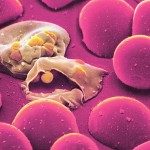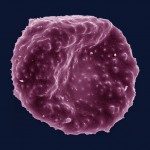Lien vers Pubmed [PMID] – 25329441
Cell. Microbiol. 2015 Apr;17(4):542-58
Plasmodium spp., which causes malaria, produces a histamine-releasing factor (HRF), an orthologue of mammalian HRF. Histamine-releasing factor produced by erythrocytic stages of the parasite is thought to play a role in the pathogenesis of severe malaria. Here, we show in a rodent model that HRF is not important during the erythrocytic but pre-erythrocytic phase of infection, which mainly consists in the transformation in the liver of the mosquito-injected parasite form into the erythrocyte-infecting form. Development of P. berghei ANKA cl15cy1 liver stages lacking HRF is impaired and associated with an early rise in systemic IL-6, a cytokine that strongly suppresses development of Plasmodium liver stages. The defect is rescued by injection of anti-IL-6 antibodies or infection in IL-6-deficient mice and parasite HRF is sufficient to decrease IL-6 synthesis, indicating a direct role of parasite HRF in reducing host IL-6. The target cells modulated by HRF for IL-6 production at early time points during liver infection are neutrophils. Parasite HRF is thus used to down-regulate a cytokine with anti-parasite activity. Our data also highlight the link between a prolonged transition from liver to blood-stage infection and reduced incidence of experimental cerebral malaria.





